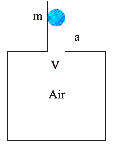Find the torque of a force 7ˆi+3ˆj–5ˆk about the origin. The force acts on a particle whose position vector is ˆi–ˆj+ˆk.Solution in Bengali
Here r=ˆi−ˆj+ˆk
and F=7ˆi+3ˆj−5ˆk
We shall use the determinant rule to find the torque τ=r×F
τ=∣∣
∣
∣∣ˆiˆjˆk1−1173−5∣∣
∣
∣∣=(5−3)ˆi−(−5−7)ˆj+(3−(−7))ˆk
or τ=2ˆi+12ˆj+10ˆk
Topper's Solved these Questions
- SYSTEMS OF PARTICLES AND ROTATIONAL MOTIONBOOK - NCERT BANGLISHCHAPTER - SYSTEMS OF PARTICLES AND ROTATIONAL MOTIONEXERCISE - EXERCISES
26 Videos
- SYSTEMS OF PARTICLES AND ROTATIONAL MOTIONBOOK - NCERT BANGLISHCHAPTER - SYSTEMS OF PARTICLES AND ROTATIONAL MOTIONEXERCISE - EXERCISES (TRUE OR FALSE)
3 Videos
- OSCILLATIONSBOOK - NCERT BANGLISHCHAPTER - OSCILLATIONSEXERCISE - Additional Exercises
6 Videos
- THERMAL PROPERTIME OF MATTERBOOK - NCERT BANGLISHCHAPTER - THERMAL PROPERTIME OF MATTEREXERCISE - EXERCISES
30 Videos
Similar Questions
Give the location of the centre of mass of a (i) sphere, (ii) cylinder, (iii) ring, and (iv) cube, each of uniform mass density. Does the centre of mass of a body necessarily lie inside the body ?
View SolutionThe instantaneous speed of the point of contact during rolling is zero.
View SolutionAn air chamber of volume V has a neck area of cross section a into which a ball of mass m just fits and can move up and down without any friction (Fig.14.27). Show that when the ball is pressed down a little and released , it executes SHM. Obtain an expression for the time period of oscillations assuming pressure-volume variations of air to be isothermal [see Fig. 14.27].

View SolutionThe triple points of neon and carbon dioxide are 24.57K and 216.55K respectively. Express these temperatures on the Celsius and Fahrenheit scales.
View SolutionFind the torque of a force (5ˆi−2ˆj+3ˆk) about the origin, which acts on a particle whose position vector is (ˆi−ˆj+ˆk).
View SolutionFind the torque of a force (7 hati + 3hatj - 5hatk) about the origin. The force acts on a particle whose position vector is (hati - hatj + hatk) .
View Solutionमूल बिंदु कि परितः, बल 7ˆi+3ˆj−5ˆk का बल आघूर्ण ज्ञात कीजिये । बल जिस कण पर लगता हैं उसका स्तिथि सदिश ˆi−ˆj+ˆk हैं ।
View SolutionFind the torque of a force 7hati - 3hatj - 5hatk about the origin which acts on a particle whose position vectors is hati + hatj - hatk
View SolutionFind the torque of a corce 7ˆi−3ˆj−5ˆk about the origin which acts on a particle whose position vector is ˆi+ˆj−ˆk
Given: →F=7ˆi−3ˆj−5ˆk
View SolutionFind the torque of a corce 7ˆi−3ˆj−5ˆk about the origin which acts on a particle whose position vector is ˆi+ˆj−ˆk
Given: →F=7ˆi−3ˆj−5ˆk
View SolutionFind the torque of a corce 7ˆi−3ˆj−5ˆk about the origin which acts on a particle whose position vector is ˆi+ˆj−ˆk
Given: →F=7ˆi−3ˆj−5ˆk
View SolutionFind the torque of a force 7ˆi+3ˆj−5ˆk about the origin. The force acts on a particle whose position vector is ˆi−ˆj+ˆk
View Solutionमूल बिन्दु के परितः 7ˆi+3ˆj−5ˆk का बल आघूर्ण ज्ञात कीजिए। बल जिस कण पर लगता है उसका स्थिति सदिश ˆi−ˆj+ˆkहै
View SolutionFind the torque of a force 7ˆi+3ˆj–5ˆk about the origin. The force acts on a particle whose position vector is ˆi–ˆj+ˆk.
View SolutionFind the torque of a force 7hati + 3hatj – 5hatk about the origin. The force acts on a particle whose position vector is hati – hatj + hatk .
View Solution